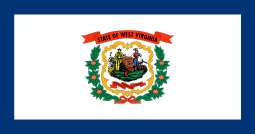John E. Kenna
| John E. Kenna | |
|---|---|
 | |
| United States Senator from West Virginia | |
|
In office March 4, 1883 – January 11, 1893 | |
| Preceded by | Henry G. Davis |
| Succeeded by | Johnson N. Camden |
| Member of the U.S. House of Representatives from West Virginia's 3rd district | |
|
In office March 4, 1877 – March 3, 1883 | |
| Preceded by | Frank Hereford |
| Succeeded by | Charles P. Snyder |
| Personal details | |
| Born |
April 10, 1848 St. Albans, West Virginia |
| Died |
January 11, 1893 (aged 44) Washington, D.C. |
| Political party | Democratic |
John Edward Kenna (April 10, 1848 – January 11, 1893) was an American politician who was a Senator from West Virginia from 1883 until his death.
Biography
Kenna was born near Colemouth, Virginia, in Kanawha County (now St. Albans, West Virginia) and lived his early life at Upper Falls, where his father was lockmaster and owned a sawmill.[1] He had little education, and at the age of 16 he served in the "Iron Brigade" with General Joseph O. Shelby in the Confederate States Army and was wounded. After returning home, he read law and was admitted to the bar in 1870. He became very active in the emerging Democratic Party of West Virginia.
He rose from prosecuting attorney of Kanawha County in 1872 to Justice pro tempore of the county circuit in 1875, and to the United States House of Representatives in 1876. While in the House he championed railroad legislation and crusaded for aid for slack-water navigation to help the coal, timber, and salt industries in his state. These activities earned him a seat in the United States Senate in 1883, where he continued fighting for his two causes.
Kenna became Democratic minority leader and emerged as a powerful and controversial speaker on the issue of the independence of the executive branch of the government. He forcefully defended President Grover Cleveland on several issues and indicted the Senate Republican majority for failure to pass tariff reforms. His brilliant career was cut short with his sudden death at the age of 44 on January 11, 1893.
Kenna is the namesake of the town of Kenna, West Virginia.[2] In 1901, the state of West Virginia donated a marble statue of Kenna to the U.S. Capitol's National Statuary Hall Collection.
See also
References
- ↑ Courtesy of Dr. William H. Dean, Ph.D. From Coal, Steamboats, Timber and Trains: The Early Industrial History of St. Albans, West Virginia & The Coal River, 1850-1925. "Archived copy". Archived from the original on 2012-04-26. Retrieved 2011-12-14. UpperFallsWV.blog.com
- ↑ Kenny, Hamill (1945). West Virginia Place Names: Their Origin and Meaning, Including the Nomenclature of the Streams and Mountains. Piedmont, WV: The Place Name Press. p. 346.
External links
| Wikimedia Commons has media related to John Edward Kenna. |
| Wikisource has original works written by or about: John E. Kenna |
- Architect of the Capitol/Capitol Complex/Art/John E. Kenna
- US Congress Biographical Directory
- Finding Aid for John Edward Kenna Collection, WV State Archives and History
| U.S. House of Representatives | ||
|---|---|---|
| Preceded by Frank Hereford |
U.S. Representative of West Virginia's 3rd Congressional District 1877–1883 |
Succeeded by Charles P. Snyder |
| U.S. Senate | ||
| Preceded by Henry G. Davis |
U.S. Senator (Class 2) from West Virginia 1883–1893 Served alongside: Johnson N. Camden, Charles J. Faulkner |
Succeeded by Johnson N. Camden |
| 45th | Senate: H. Davis • F. Hereford | House: B. Wilson • J. Kenna • B. Martin |
| 46th | Senate: H. Davis • F. Hereford | House: B. Wilson • J. Kenna • B. Martin |
| 47th | Senate: H. Davis • J. Camden | House: B. Wilson • J. Kenna • J. Hoge |
| 48th | Senate: J. Camden • J. Kenna | House: W. Wilson • N. Goff Jr. • C. Snyder • E. Gibson |
| 49th | Senate: J. Camden • J. Kenna | House: W. Wilson • N. Goff Jr. • C. Snyder • E. Gibson |
| 50th | Senate: J. Kenna • C. Faulkner Jr. | House: W. Wilson • N. Goff Jr. • C. Snyder • C. Hogg |
| 51st | Senate: J. Kenna • C. Faulkner Jr. | House: W. Wilson • J. Alderson • J. Pendleton • J. Jackson • G. Atkinson • C. Smith |
| 52nd | Senate: J. Kenna • C. Faulkner Jr. • J. Camden | House: W. Wilson • J. Alderson • J. Pendleton • J. Capehart |


